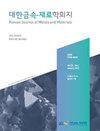Laser Cladding of Alloy 82 Powder for Corrosion Protection in Small Modular Reactors
IF 1.1
4区 材料科学
Q4 MATERIALS SCIENCE, MULTIDISCIPLINARY
引用次数: 0
Abstract
There has been an increased demand for surface modification technologies to enhance corrosionresistance and wear-resistance. Among the representative surface coating technologies, laser cladding has attracted great attention because of its multiple advantages including low heat input, low dilution ratio, controllable clad height, etc. Recently, laser cladding has been considered as a surface coating technology for the next-generation small modular reactor, although submerged arc welding was utilized for the 3rd generation nuclear reactor. Cobalt-free materials are required as cladding materials in the nuclear reactor because cobalt has a long half-life. In this work, nickel based cobalt-free Alloy 82 powder was utilized. The main experimental parameters for laser cladding were intensively investigated by varying laser power, scan speed, powder supply, carrier and shield gas, overlap ratio, etc. Additionally, cross-sectional area calculation and EPMA analysis were carried out to examine the dilution ratio. Mechanical properties were also evaluated using microhardness tests and wear tests at high temperatures. Finally, corrosion tests were performed to compare a laser clad surface with an uncoated carbon steel surface. Our study indicates that the laser cladding using Alloy 82 powder is feasible for corrosion protection in next-generation small modular reactors.激光熔覆合金82粉末在小型模块化反应器中的防腐作用
为了提高材料的耐腐蚀性和耐磨性,对表面改性技术的需求不断增加。在具有代表性的表面涂层技术中,激光熔覆以其低热输入、低稀释比、熔覆高度可控等优点而备受关注。虽然第三代核反应堆采用了埋弧焊,但近年来,激光熔覆技术已被认为是下一代小型模块化反应堆的表面涂层技术。由于钴的半衰期很长,所以需要无钴材料作为核反应堆的包层材料。本研究采用了镍基无钴合金82粉末。研究了激光熔覆的主要实验参数,包括激光功率、扫描速度、供粉量、载流子和保护气体、重叠率等。此外,还进行了横截面积计算和EPMA分析,以检验稀释比。还通过显微硬度测试和高温磨损测试评估了机械性能。最后,进行了腐蚀试验,以比较激光熔覆表面与未熔覆的碳钢表面。研究表明,采用Alloy 82粉末进行激光熔覆对下一代小型模块化反应器的防腐是可行的。
本文章由计算机程序翻译,如有差异,请以英文原文为准。
求助全文
约1分钟内获得全文
求助全文
来源期刊

Korean Journal of Metals and Materials
MATERIALS SCIENCE, MULTIDISCIPLINARY-METALLURGY & METALLURGICAL ENGINEERING
CiteScore
1.80
自引率
58.30%
发文量
100
审稿时长
4-8 weeks
期刊介绍:
The Korean Journal of Metals and Materials is a representative Korean-language journal of the Korean Institute of Metals and Materials (KIM); it publishes domestic and foreign academic papers related to metals and materials, in abroad range of fields from metals and materials to nano-materials, biomaterials, functional materials, energy materials, and new materials, and its official ISO designation is Korean J. Met. Mater.
 求助内容:
求助内容: 应助结果提醒方式:
应助结果提醒方式:


